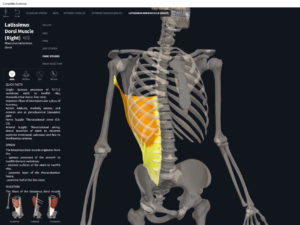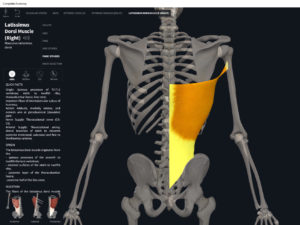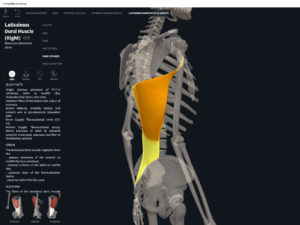Anatomy & Physiology: Muscles—Latissimus Dorsi.
Structure.
- Origin: spinous processes of T7-T12; lumbar vertebrae; iliac and sacral crests; thoracolumbar fascia; ribs 9-12.
- Insertion: inferior angle of scapula; intertubecular groove of humerus.
Function.
- Concentric action: shoulder extension, adduction, and internal/medial rotation; draws arm inferiorly and posteriorly; scapular depression.
- Reverse mover action: contralateral rotation of the pelvis and trunk at spinal joints. Ipsilateral elevation of pelvis at lumbosacral joint. Anterior tilt of pelvis. Trunk elevation.
- Eccentric action: shoulder flexion, abduction, external rotation and spinal flexion. Controls/restrains/slows lateral rotation, abduction, and flexion of arm. Controls/restrains/slows ipsilateral rotation, ipsilateral depression, posterior tilt of pelvis. Controls/restrains/slows ipsilateral rotation, flexion, and depression of trunk. Controls/restrains/slows scapula.
- Isometric action: stabilization of the lumbo-pelvic hip complex and shoulder. Stabilizes spinal joints.
- Innervation: thoracodorsal nerves.
- Arterial supply: thoracodorsal artery (branch of subscapular artery); dorsal branches of posterior intercostal arteries (branches of aorta).
Clinical Significance.
More.
- https://www.physio-pedia.com/Latissimus_Dorsi_Muscle
- https://www.youtube.com/watch?v=Qy4yPzMCSwA
- https://www.youtube.com/watch?v=ayeS8LZpfmE
References
Biel, A. (2015). Trail guide to the body: A hands-on guide to locating muscles, bones and more.
Cedars-Sinai. (2018). Vertebrae of the spine. Retrieved from https://www.cedars-sinai.org/health-library/diseases-and-conditions/v/vertebrae-of-the-spine.html
Clark, M., Lucett, S., Sutton, B. G., & National Academy of Sports Medicine. (2014). NASM essentials of corrective exercise training. Burlington, MA: Jones & Bartlett Learning.
Jenkins, G., & Tortora, G. J. (2012). Anatomy and Physiology: From Science to Life, 3rd Edition International Stu. John Wiley & Sons.
Muscolino, J. E. (2017). The muscular system manual: The skeletal muscles of the human body.



